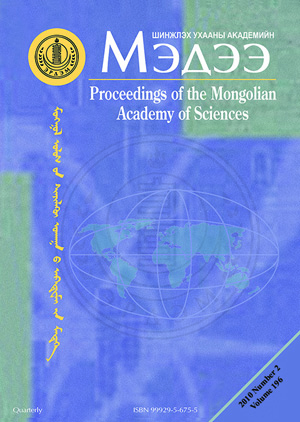Ямаан арц (Juniperus sibirica Burgsd.)-ны мутагений үйлчлэлийг дарангуйлах идэвхийн судалгаа
DOI:
https://doi.org/10.5564/pmas.v57i196.797Abstract
This study evaluated the antimutagenic and cytotoxic effects of some plants growing in Mongolia and plants were selected on the basis of their traditional use in various diseases. Over the past years numbers of cancer incidences are increasing in Mongolia. There are accounted several reasons, in particular the use of less guaranteed imported food, heavy air pollution, environmental contamination and low life quality of the population. Therefore, we attempted to search antimutagenic activity among plants from the Mongolian flora and possibility of their use for preventing and treating cancer cases. The study might promote the way to fight with cancer, if we can find antimutagenic active compounds from natural crude drugs, including medicinal plants.
We have examined the antimutagenic and cytotoxic effects of 20 samples, which prepared from different parts of 10 plants species. The antimutagenic and cytotoxic tests were performed as described by Ames. The bacteria used in the test are a strain of Salmonella typhimurium TA1537, and using 9-aminoacridine as direct mutagen.
From the 20 plant extracts studied, extracts of Achnatherum splendens Trin. (aerial parts), Cynoglossum divaricatum Steph. (roots, stems), Juniperus sibirica Burgsd. (leaf, stem) strongly inhibited mutagenicity of 9-aminoacridine and their inhibition activity was 49.7%, 41.5%, 61.5%, 40% and 43% respectively. All plant extracts have not any cytotoxic effect on Salmonella typhimurium TA1537.
From the high active plants Juniperus sibirica Burgsd. (aerial parts) which was selected for further detailed study 3 pure active compounds as JS-1, JS-2 and JS-3 were isolated. The compound JS-3 showed the high (55%) antimutagenic activity and its molecular structure was determined as cetyl alcohol or hexadecanol-1 according to its physical and chemical characteristics as well as 1H-NMR and 13C-NMR spectroscopy analysis.
We have revealed that the availability of plants possessing antimutagenic activity among the Mongolian flora. Consequently, it is needed further detailed study of active plants, isolation and identification of active pure compounds, as well as possible application of the active plant products in the medicinal practice.
Downloads
1827
Downloads
Published
How to Cite
Issue
Section
License
Copyright on any research article in the Proceedings of the Mongolian Academy of Sciences is retained by the author(s).
The authors grant the Proceedings of the Mongolian Academy of Sciences a license to publish the article and identify itself as the original publisher.

Articles in the Proceedings of the Mongolian Academy of Sciences are Open Access articles published under a Creative Commons Attribution 4.0 International License CC BY.
This license permits use, distribution and reproduction in any medium, provided the original work is properly cited.

